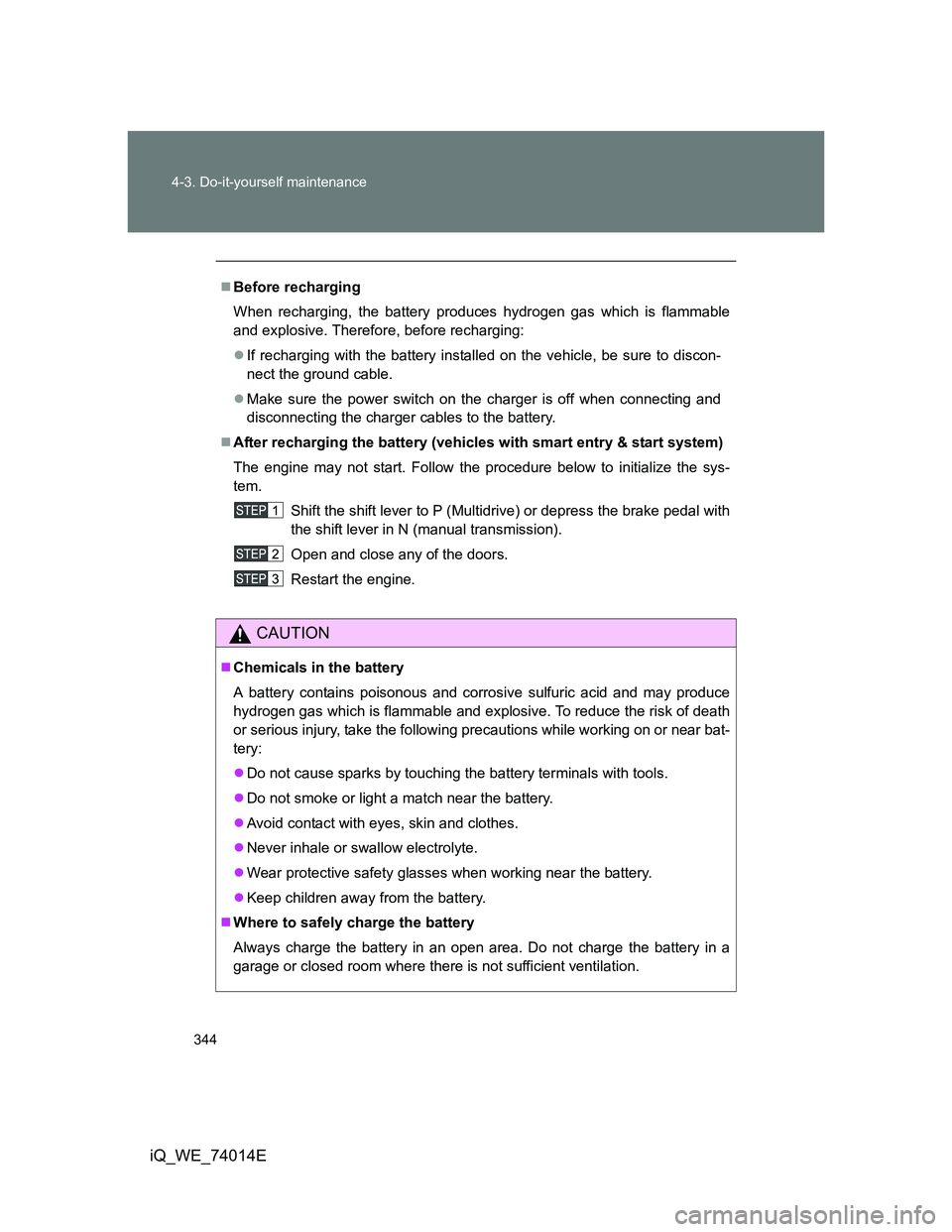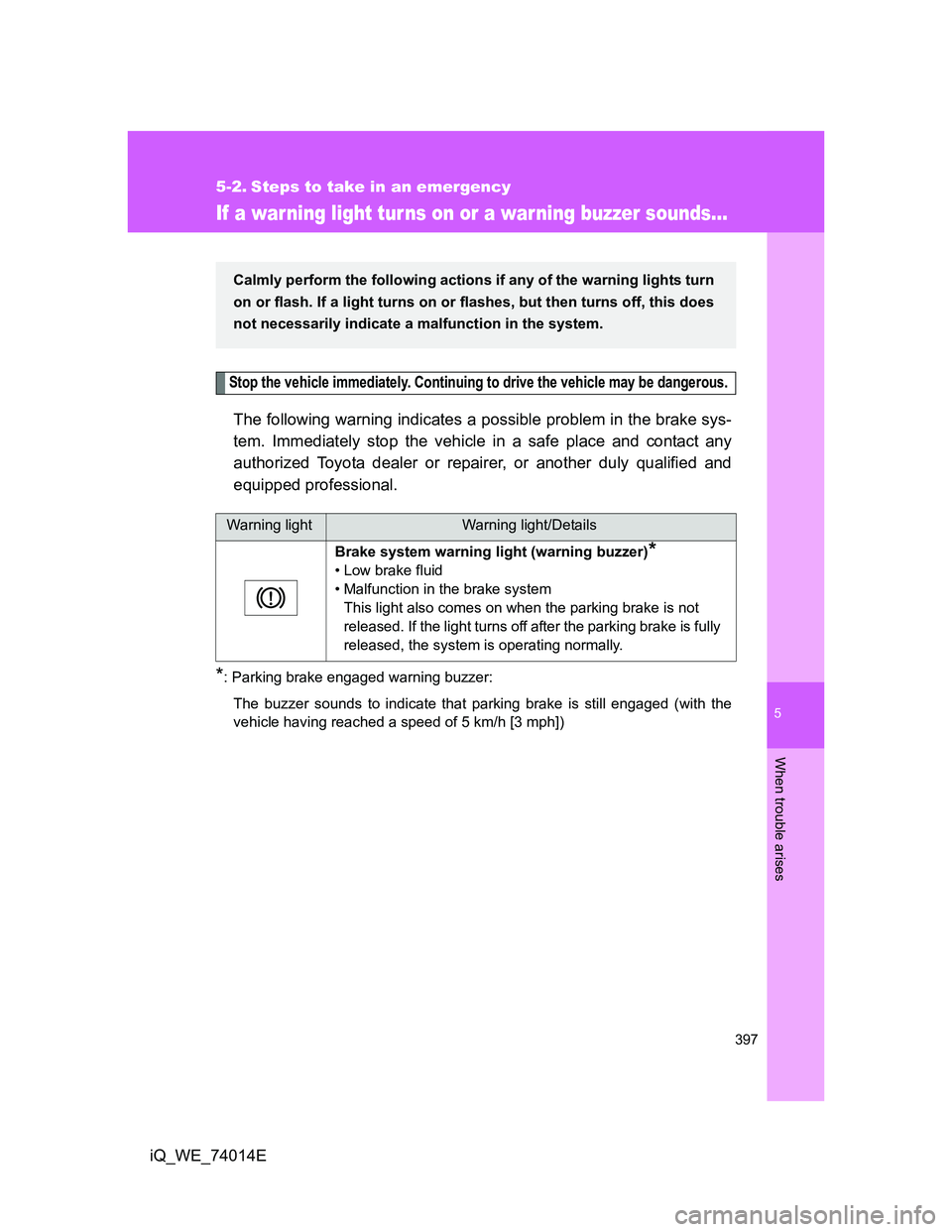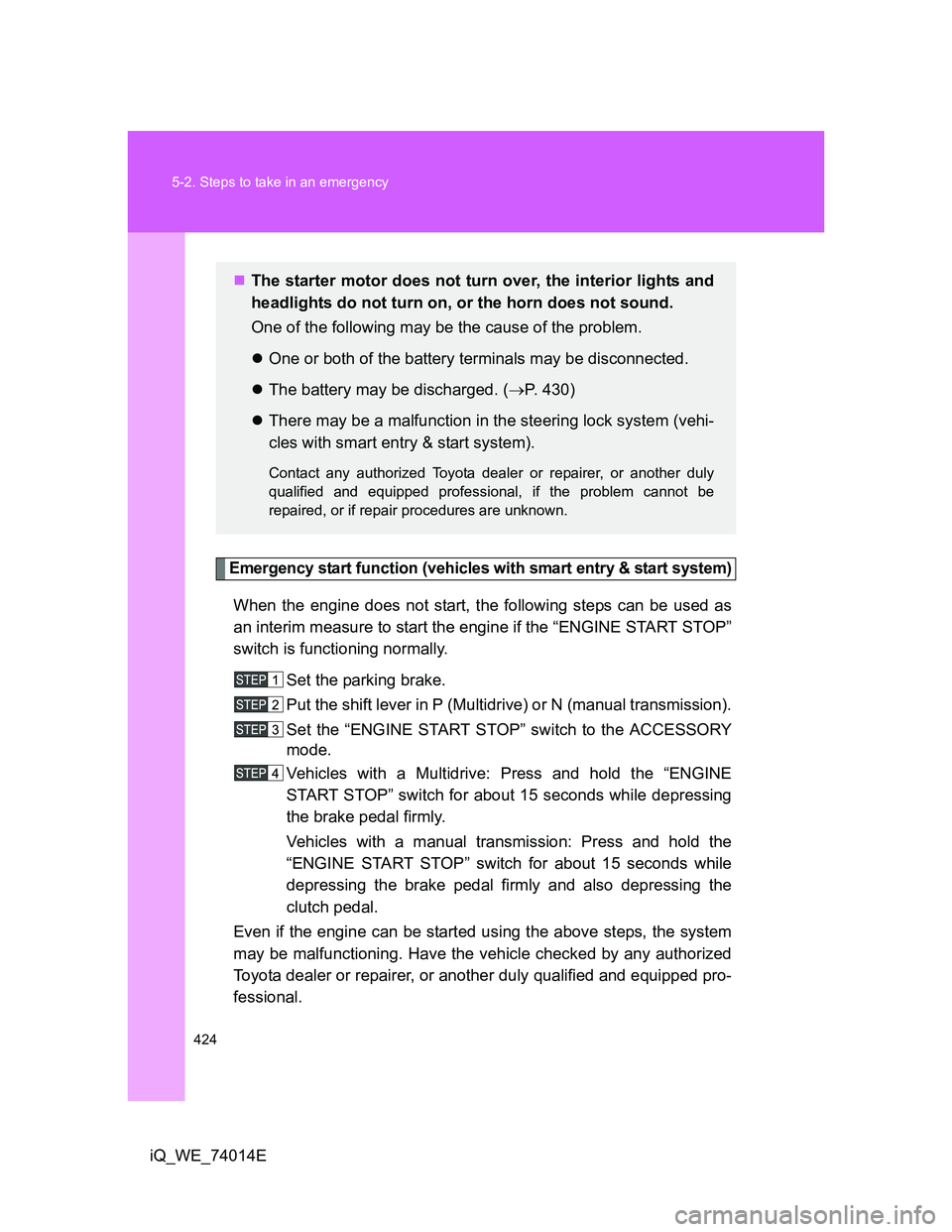Page 318 of 476
318 4-3. Do-it-yourself maintenance
iQ_WE_74014E
NOTICE
If you remove the air cleaner
Driving with the air cleaner removed may cause excessive engine wear due
to dirt in the air.
If the fluid level is low or high
It is normal for the brake fluid level to go down slightly as the brake pads
wear or when the fluid level in the accumulator is high.
If the reservoir needs frequent refilling, it may indicate a serious problem.
Page 344 of 476

344 4-3. Do-it-yourself maintenance
iQ_WE_74014E
Before recharging
When recharging, the battery produces hydrogen gas which is flammable
and explosive. Therefore, before recharging:
If recharging with the battery installed on the vehicle, be sure to discon-
nect the ground cable.
Make sure the power switch on the charger is off when connecting and
disconnecting the charger cables to the battery.
After recharging the battery (vehicles with smart entry & start system)
The engine may not start. Follow the procedure below to initialize the sys-
tem.
Shift the shift lever to P (Multidrive) or depress the brake pedal with
the shift lever in N (manual transmission).
Open and close any of the doors.
Restart the engine.
CAUTION
Chemicals in the battery
A battery contains poisonous and corrosive sulfuric acid and may produce
hydrogen gas which is flammable and explosive. To reduce the risk of death
or serious injury, take the following precautions while working on or near bat-
tery:
Do not cause sparks by touching the battery terminals with tools.
Do not smoke or light a match near the battery.
Avoid contact with eyes, skin and clothes.
Never inhale or swallow electrolyte.
Wear protective safety glasses when working near the battery.
Keep children away from the battery.
Where to safely charge the battery
Always charge the battery in an open area. Do not charge the battery in a
garage or closed room where there is not sufficient ventilation.
Page 395 of 476

5
395
5-1. Essential information
When trouble arises
iQ_WE_74014E
If you think something is wrong
If you notice any of the following symptoms, your vehicle probably
needs adjustment or repair. Contact any authorized Toyota dealer or
repairer, or another duly qualified and equipped professional, as
soon as possible.
Visible symptoms
Fluid leaks under the vehicle
(Water dripping from the air conditioning system after use is
normal.)
Flat-looking tires or uneven tire wear
High engine coolant temperature warning light flashes or
comes on
Low engine coolant temperature indicator comes on or does
not come on continuously
Audible symptoms
Changes in exhaust sound
Excessive tire squeal when cornering
Strange noises related to the suspension system
Pinging or other noises related to the engine
Operational symptoms
Engine missing, stumbling or running rough
Appreciable loss of power
Vehicle pulls heavily to one side when braking
Vehicle pulls heavily to one side when driving on a level road
Loss of brake effectiveness, spongy feeling, pedal almost
touches the floor
Page 397 of 476

5
397
When trouble arises
iQ_WE_74014E
5-2. Steps to take in an emergency
If a war ning light tur ns on or a warning buzzer sounds...
Stop the vehicle immediately. Continuing to drive the vehicle may be dangerous.
The following warning indicates a possible problem in the brake sys-
tem. Immediately stop the vehicle in a safe place and contact any
authorized Toyota dealer or repairer, or another duly qualified and
equipped professional.
*: Parking brake engaged warning buzzer:
The buzzer sounds to indicate that parking brake is still engaged (with the
vehicle having reached a speed of 5 km/h [3 mph])
Warning lightWarning light/Details
Brake system warning light (warning buzzer)
*
• Low brake fluid
• Malfunction in the brake system
This light also comes on when the parking brake is not
released. If the light turns off after the parking brake is fully
released, the system is operating normally.
Calmly perform the following actions if any of the warning lights turn
on or flash. If a light turns on or flashes, but then turns off, this does
not necessarily indicate a malfunction in the system.
Page 399 of 476
5
399 5-2. Steps to take in an emergency
When trouble arises
iQ_WE_74014E
Follow the correction procedures.
After taking the specified steps to correct the suspected problem,
check that the warning light turns off.
SRS warning light
Indicates a malfunction in:
• The SRS airbag system; or
• The seat belt pretensioner system.
ABS warning light
Indicates a malfunction in:
• The ABS; or
• The brake assist system.
Electric power steering warning light (warning buzzer)
Indicates a malfunction in the EPS (Electric Power Steer-
ing) system.
Slip indicator
The indicator comes on to indicates a malfunction in:
• The VSC system; or
• The TRC system.
Warning lightWarning light/DetailsCorrection procedure
Open door warning light
Indicates that a door is not fully
closed.Check that all doors are
closed.
(Flashing)Low fuel level warning light
*1
Indicates that remaining fuel is
about 5.9 L (1.6 gal., 1.3 Imp.
gal.) or less.Refuel the vehicle.
Warning lightWarning light/Details
Page 424 of 476

424 5-2. Steps to take in an emergency
iQ_WE_74014E
Emergency start function (vehicles with smart entry & start system)
When the engine does not start, the following steps can be used as
an interim measure to start the engine if the “ENGINE START STOP”
switch is functioning normally.
Set the parking brake.
Put the shift lever in P (Multidrive) or N (manual transmission).
Set the “ENGINE START STOP” switch to the ACCESSORY
mode.
Vehicles with a Multidrive: Press and hold the “ENGINE
START STOP” switch for about 15 seconds while depressing
the brake pedal firmly.
Vehicles with a manual transmission: Press and hold the
“ENGINE START STOP” switch for about 15 seconds while
depressing the brake pedal firmly and also depressing the
clutch pedal.
Even if the engine can be started using the above steps, the system
may be malfunctioning. Have the vehicle checked by any authorized
Toyota dealer or repairer, or another duly qualified and equipped pro-
fessional.
The starter motor does not turn over, the interior lights and
headlights do not turn on, or the horn does not sound.
One of the following may be the cause of the problem.
One or both of the battery terminals may be disconnected.
The battery may be discharged. (P. 430)
There may be a malfunction in the steering lock system (vehi-
cles with smart entry & start system).
Contact any authorized Toyota dealer or repairer, or another duly
qualified and equipped professional, if the problem cannot be
repaired, or if repair procedures are unknown.
Page 462 of 476
462
iQ_WE_74014E
Abbreviation list
Abbreviation/Acronym list
ABBREVIATIONSMEANING
ABS Anti-Lock Brake System
ACC Accessory
CRS Child Restraint System
ELR Emergency Locking Retractor
EPS Electric Power Steering
LED Light Emitting Diode
SRS Supplemental Restraint System
TRC Traction Control
TWI Treadwear Indicators
VIN Vehicle Identification Number
VSC Vehicle Stability Control
Page 463 of 476

463
iQ_WE_74014E
Alphabetical index
Alphabetical index
A/C..................................... 238, 244
ABS ........................................... 224
Air conditioning filter .............. 354
Air conditioning system
Air conditioning filter.............. 354
Automatic air conditioning
system ................................ 244
Manual air conditioning
system ................................ 238
Airbags
Airbag manual on-off
system ................................ 159
Airbag operating
conditions ........................... 127
Airbag precautions for
your child ............................ 132
Airbag warning light .............. 398
Curtain shield airbag
precautions ......................... 132
Knee airbag precautions ....... 132
Locations of airbags .............. 124
Modification and disposal
of airbags ............................ 136
Proper driving
posture........................ 122, 132
Rear window curtain shield
airbag precautions .............. 132
Seat cushion airbag
precautions ......................... 132
Side airbag precautions ........ 132
SRS airbag precautions ........ 132
SRS airbags .......................... 124
Alarm......................................... 119
Antenna ...................... 41, 264, 306
Anti-lock brake system ........... 224
Assist grips .............................. 298
Audio input ............................... 282Audio system
Antenna ................................ 264
Audio input ............................ 282
AUX port ............................... 282
CD player .............................. 265
MP3/WMA disc ..................... 272
Optimal use........................... 280
Portable music player ........... 282
Radio .................................... 260
Steering wheel audio
switch ................................. 284
Type ...................................... 257
Automatic air conditioning
system .................................... 244
Automatic light control
system .................................... 211
AUX port ................................... 282
Auxiliary box ............................ 290
Back-up lights
Replacing light bulbs............. 373
Wattage ................................ 456
Back door
Back door................................ 75
Smart entry & start system ..... 39
Wireless remote control .......... 62
Battery
Checking ............................... 342
If the vehicle battery
is discharged ...................... 430
Preparing and checking
before winter....................... 231
Bottle holder ............................ 289
Brakes
Parking brake........................ 194
Brake assist ............................. 224
Break-in tips ............................. 167A
B